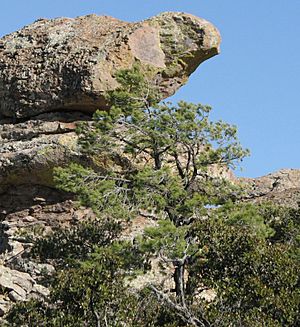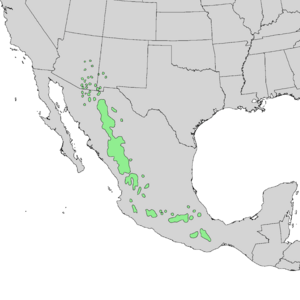Chihuahua pine facts for kids
Quick facts for kids Chihuahua pine |
|
|---|---|
 |
|
| Pinus leiophylla subsp. chihuahuana, Bird Rock, Chiricahua National Monument, Arizona | |
| Conservation status | |
| Scientific classification | |
| Genus: |
Pinus
|
| Species: |
leiophylla
|
 |
|
| Natural range | |
The Chihuahua pine (Pinus leiophylla) is a type of tree. It is also known as the smooth-leaf pine or yellow pine. In Mexico, people call it tlacocote or ocote chino. This tree mostly grows in Mexico. You can also find it in a small part of the United States. This includes southeast Arizona and southwest New Mexico.
In Mexico, it grows along the Sierra Madre Occidental and Sierra Madre del Sur mountain ranges. Its habitat stretches from Chihuahua to Oaxaca. These trees grow at high altitudes, usually between 1600 and 3000 meters (about 5,200 to 9,800 feet). They need about 600 to 1000 millimeters (24 to 39 inches) of rain each year. Most of this rain falls in the summer. Chihuahua pines can also handle cold weather and frosts in winter.
Contents
What Does the Chihuahua Pine Look Like?
This tree belongs to the Pinaceae family, which includes all pines. It can grow very tall, reaching 20 to 30 meters (65 to 98 feet) high. Its trunk can be 35 to 80 centimeters (14 to 31 inches) wide.
The needles of the Chihuahua pine are special. They grow in bundles of three to five needles. Each needle is about 5 to 10 centimeters (2 to 4 inches) long. Sometimes they can be as long as 15 centimeters (6 inches). They are a bright, shiny green or yellowish-green color.
The pine cones are oval-shaped. They are usually 4 to 7 centimeters (1.5 to 2.75 inches) long. Sometimes they can grow up to 8 centimeters (3 inches). These cones grow on a short stalk, about 1 to 2 centimeters (0.4 to 0.8 inches) long. What's unusual about these cones is how long they take to grow. They need about 30 to 32 months to fully mature. This is a whole year longer than most other pine trees! The bark of the tree is gray-brown and has cracks in it.
Different Types of Chihuahua Pine
There are two main types, or subspecies, of Pinus leiophylla. Some scientists even think they are different species.
- Pinus leiophylla subsp. leiophylla
- Pinus leiophylla subsp. chihuahuana
- This type has thicker needles. They are about 0.9 to 1.3 millimeters wide.
- Its needles usually grow in bundles of three.
- This subspecies is found in the northern part of the range, from Durango to Arizona.
- It can handle cold temperatures, down to about -10°C to -15°C (14°F to 5°F). It also grows in very dry places.
- The differences in its needles help it survive in these tougher conditions. This subspecies is also known as Pinus chihuahuana.
Where Chihuahua Pines Live and How They Survive
Chihuahua pines often grow mixed with other types of pines and juniper trees. In Arizona, they are often found with Apache Pine and Alligator Juniper. Sometimes, they even grow in groups made up only of Chihuahua pines.
The places where these trees live often have wildfires. The Chihuahua pine has some amazing ways to deal with fire. If the top part of the tree (the crown) is burned away, the trunk can still survive. Its thick bark protects it. Then, new shoots can grow from the trunk to form a new crown.
This ability is very rare among pine trees. Only a few other pines can do this, like the Pitch Pine (P. rigida) and the Canary Island Pine (P. canariensis). These trees are not closely related to the Chihuahua pine. This means they probably developed this fire survival skill on their own. This is a cool example of convergent evolution. It's when different species develop similar traits because they face similar challenges.
How People Use Chihuahua Pine
The wood from the Pinus leiophylla tree is very strong and hard. It is also quite dense. People use this wood for many things. It is used in construction to build things. It is also used as firewood to keep warm. Sometimes, it is even used to make railroad ties.
This tree is also planted in other parts of the world. There are large areas of Chihuahua pines planted in South Africa and Queensland, Australia. It is also grown for business in countries like Kenya, Malawi, Zimbabwe, and Zambia. These trees are planted in areas that are high up in the mountains.
See also
 In Spanish: Pino chimonque para niños
In Spanish: Pino chimonque para niños


